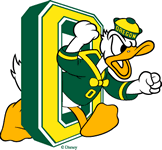|
|
HOME ~ College Football History |
The Evolution of a Mascot
Even though the
uniforms have changed, no longer bearing his fighting countenance
bursting through the block "O" logo, Donald Duck remains as one of the
most recognizable and lovable mascots on the collegiate sports land
scene.
Before Donald came to Eugene, thanks to the benevolence of Walt Disney,
no duck seemed destined to represent the school as its mascot. In fact,
during the University's early days, Oregon's pride was tied to a
patriotic band of New England anglers with soggy soles. University
students re-ferred to themselves as Webfooters.
Then through the intervening decades, once the duck nickname had found
its rightful home, the downy mascot faced challenges from the Humane
Society, the student newspaper, a football coach who preferred that his
Donald bare his teeth,
 and a basketball coach who refused to even utter
his name. and a basketball coach who refused to even utter
his name.
Originally, the prevailing campus sentiment was that the University
shouldn't degrade itself by dabbling in such nonsense as nicknames and
water fowl. The nickname game began early this century when Oregon was
originally known as "The Webfoot State." Students took a shine to the
slogan and referred to themselves as Webfoots and their yearbook as "The
Webfoot." (When the new motto became "The Beaver State" in 1909, Oregon
students changed the yearbook name to "The Beaver" before switching
back.)
The Webfoots reference can be traced to a hearty band of Massachusetts
fishermen, who in 1776 helped save General George Washington and some
10,000 of his troops from imminent defeat at the hands of the British.
When many of the Webfoots' ancestors migrated west of the Cascades and
settled in the Willamette Valley in the 1840s, the name stuck to their
muddy shoes and came with them.
L.H. Gregory, sports editor of The Oregonian, has been credited with
coining Webfoots as the school's athletic nickname, even though the
students had seen themselves as such since the turn of the century.
Headline writers searching for ways to parse Webfoots into their sports
pages began churning out Ducks, which the students eventually voted as
their new nickname over Timberwolves and Lum-berjacks. A second
student-body election in 1932 beat back the challenges of Trappers,
Pioneers, Yellowjackets and Spearsmen, the latter in honor of football
coach C.W. Spears, who left before the '32 season for a similar post at
Wisconsin.
Oregon's first live mascot had surfaced in the 1920s when "Puddles," a
resident of the nearby Millrace, was escorted to football and basketball
games by his fraternity-house neighbors. Puddles and his various
offspring were part of the Duck sports scene until the early 1940s when
repeated complaints from the Humane Society finally sucked the fun out
of bringing a live duck to games.
However, Puddles' memory was preserved in 1947 when Oregon's first
athletic director, Leo Harris, struck a handshake arrangement with Walt
Disney. Donald's likeness could serve as a mascot, as long as it was
done in good taste. The unique deal stood for 20 years, with Walt Disney
Productions providing several versions of the duck for Oregon's use,
until the cartoonist's death in 1966. That's when both parties realized
no formal contract existed granting the University the right to Donald's
image.
The best evidence Harris could offer was a photograph taken two decades
earlier showing the late Mr. Disney in an Oregon letterman's jacket with
Donald clearly visible on the front. Disney representatives agreed to
negotiate the first written contract in 1973 for the athletic
department's continued use of Donald.
However, not everyone accepted the cartoon mascot's image at face value.
Jerry Frei, Oregon's football coach for five seasons (1967-71), wanted
Donald to sport teeth in his bill to better portray his team's "Fighting
Ducks" image. And Dick Harter, the men's basketball coach for seven
years (1971-78), disdained the Duck nickname altogether and insisted
that any public relations materials refer only to his "Kamikaze Kids."
Then Oregon's duck endured another popularity contest in 1978 when a
cartoonist for the student newspaper pushed his Mallard Drake as a
suitable successor to Donald, prompting one local high school student to
comment that "if that sleazy Duck makes it, I'm going to OSU." Donald
was the students' overwhelming choice by a 2-to-1 landslide in an
election that saw more than twice the typical voter turnout on campus.
Donald Duck found even more support for his 50th birthday celebration in
1984 during a visit to the Eugene City Airport that drew 3,000 to 4,000
fans for the presentation of an academic cap and gown to Donald, who was
named an honorary alumnus of the University of Oregon. Thousands of area
residents signed a congratulatory scroll for Donald, and that document
is now part of Disney's corporate archives.
Donald remained the lone duck mascot in any collegiate or professional
capacity until the advent of the Anaheim Mighty Ducks franchise in the
National Hockey League in 1993. Now, he looks forward to the next
millennium in yellow and green as Oregon's enduring ambassador for the
future.
Home Page

|

 and a basketball coach who refused to even utter
his name.
and a basketball coach who refused to even utter
his name.